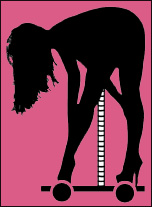1. I want to learn how to transition from punching to kicking like the big guy.
2. These guys have some serious speed.
3. To my slightly trained eye they seem to have some good boxing fundamentals.
-Sean
Thanks for this video pick, Sean.
My acquaintance with kickboxing was brief and disastrous and still hurts, having torn my aductor attachment at 20. I really can’t comment on the kicking other than to note how the weight shift enables or disables punching opportunities.
Both fighters punch well.
The short fighter favors hooking blows, which compliment his round kicks.
The short fighter also uses the spent kick to shift under a straight rear hand, which is good for the round kicker and the straight kicker when it comes to transitioning to the straight punch.
The tall fighter has good boxing form, although he could use more of a hand span, and could also transition from the raised lead foot to a jab more often. I disagree with Rufus that the corkscrew punch that “pushed” his man down was not effective.
Generally the tall kicker wants to work more straight kicks and the short kicker more round kicks, which is the same as boxing with tall punchers better served by the jab and shorter ones more at home with hooks. It is my opinion that isolating boxing is the only way to achieve a perfect balance between the kicks and punches. If the punching is not yet instinctive you will have to think about the transitions and that causes lag and interferes with timing.
Your boxing workouts should be separate from your kickboxing training, just as you should isolate jabbing from the rest of your punches. I would suggest a sparring evolution that begins with just kicking, then just kicking and jabbing, then kicking and throwing all the punches in order to identify where your transitions need work. When I sparred with Ed Jones, since my feet were worthless, he had me box, and he only kicked. He only kicked. It was, I suppose, like fighting a kangaroo. Try that.
Keep in mind, that most boxers have major flaws because they blow by the jab and that most kickboxers cannot hang in the boxing ring because they blow by the hands. One thing that is obvious from watching a lot of kick boxing is that guys with good round kicks let them become a crutch that retards the rest of their kicking arsenal and tends to limit punch transitions. For a tall guy like you I would put the rear-leg round kick on the back burner and use it only as a finishing blow, relying on front kicks, foot jabs and sidekicks, and learning to feint with the lead kick, as this can always be turned into a power jab as you set the foot down or aborted into a southpaw shift behind a week pivot to a safety jab, whichever is needed.
As for specific moments in the fight, I have these notes:
Round 1
1. The low lead leg round kicks, that also look like they could be thrown as a knee check to the body, thrown early on, right off the bell by the big man and used to set up that sneaky corkscrew punch, is not the round kick I’m talking about. Low lead round kicks can shift into a straight punch just like a front kick. I am warning about the reliance on the rear-leg round kick so many kickers rely upon.
2. At 46 seconds the short man throws an up-jab that was quite nice. And although I do not understand the kicking action, he seems to be able to throw a round kick off of this same bent lead knee. I really like the way he uses forward shifts to pursue instead of just stalking with the step drag. It seems to me that with kicks involved we are looking for foot mobility comparable to stick fighting, not boxing, and he is doing it, pressing the action.
3. As the first round wears on the big man’s lack of a hand span hurts his offense and targeting. Note the one time he extends the measure, what reach he has, I realize he can’t hang it out there or he will get his ribs kicked in. But using more than once a round and as a strike would be helpful.
Round 2
1. The replay at 3:50 shows a heart punch that knocks the short man down. It certainly did not hurt him, but would have stopped normal people, and in a knife fight, would have been a clean kill. I disagree with the commentator that going down is no big deal as it certainly is a big deal in MMA and in survival situations.
2. At 5:18 the big man throws a plunging jab that was deflected and if read by a dedicated boxer would have gotten him hurt. He needs to thrust more with the jab instead of punching down, using the rear leg to drive instead of the shoulders. This comes from not having a hand span, which is problematical because against a dangerous kicker maintaining a constant hand-span could get your ribs smashed in.
3. The tall man jabs at 5:50 using the heel of the hand. You self defense people take note. He then comes around with the jab he should have used more often at 6:03, a jab that should have been doubled.
4. At 6:54 the big man does what no tall fighter should do, goes to the glass house guard and just eats a combo. That is getting through to the neck and the legs. The problem is in kickboxing the legs are used as a high intensity weapon and then begin to fail as mobility tools as they get spent. The longer the fight goes the more it favors the puncher.
5. At 6:58 Saki finishes his combo with a straight punch which most brawlers of his type fail to do. That was good work.
6. At 7:28 the big man comes with that low kick high punch again. If only he could follow that with a jab and a sidekick it would be devastating. He tends not to exploit his successful shifts. In the closing moments his rear hand discipline, excellent throughout, saves him from a KO.
Round 3
1. Finally, at the beginning of round 3, the big man begins working behind the jab, showing that he has the tools. I would have liked him using the jab more earlier on, which would have been dicey with the short man kicking the legs and therefore would have had to have been set up with low kicks. The fact that good jabbing requires weight transfer to the lead leg makes jabbing dangerous against leg kickers when they are fresh and requires a leg offense of your own to implement. Note that Larry Holmes and Ray Mercer, hardest jabbers in boxing, fared very poorly against leg kickers.
2. At 10:38 the big man uses a step out stiff arm nicely.
3. At 11:00, the undeniable power of the front kick and the tactical utility of making the man get off line without hitting or driving him in line, convinces me that tall kickers need to do this with ruthless intent.
4. Near the close of the round the giant pumps four jabs without stepping or driving behind any of them. I do not understand what it is that keeps kickers from driving the jab with their rear leg [perhaps fatigue, perhaps a difficult shift in leg action]. But, if it is possible to use that rear leg to drive those jabs, then the opponent’s defense would have been shattered. Perhaps practicing more lead leg front kicks would help this.











